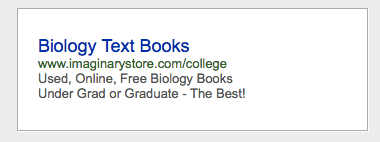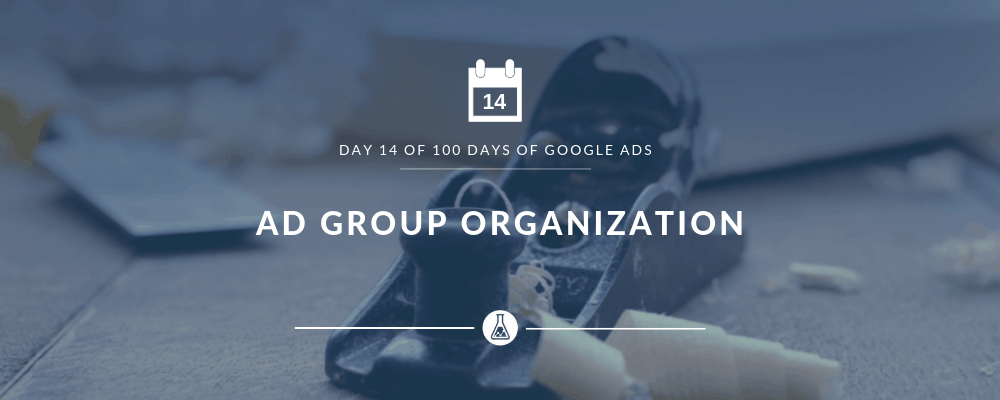There are a variety of different ways we see ad groups organized for Search Network campaigns. I’ve seen everything from:
- 100 keywords, all broad, one ad group
- 100 keywords some broad, some exact match, some phrase match, one ad group
- 1 keyword, one ad group
- 20 keywords, all of the same match type, in one ad group
- good keywords and bad keywords, in different ad groups
What is the best way to organize keywords into ad groups? First, let’s look at the goals of an effective ad group.
Ad Group Organization Rule #1: One Theme Per Ad Group
Let’s take a look at 5 keywords:
- biology text books for grad students
- best biology text books for college students
- used biology text books for college students
- free biology text books for college students
- online biology text books for college students
Now, try to write an ad that has relevance to every single keyword in the ad group.
Having trouble? Of course you are. There is no way to include all these keywords inside one ad group. When you do, your ad is clunky, and likely ineffective.

In the example above, people looking for:
- used books – want to see the best ad for used books. Your ad copy should be all about how your used books are second-to-none
- online books – want to know that your online book store is the best online book store out there! Your ad copy shouldn’t be talking about “used” books whatsoever. Instead, it should highlight the key benefits to using your online book store.
You cannot create effective ad copy when you are trying to create ad groups that include so many different themes. Don’t let a robot decide what is similar. I assure you, any “keyword grouping tool” will group “used books” and “online books” together because of the similar word “books” – but the user intent is vastly different between these keywords.
Ad Group Organization Rule #2: “About 10”
This next rule is an extension of the first. There should be “about 10” keywords per ad group. Simply put, if you have more than 10, it’s likely that you’re breaking rule #1. With more than 10 keywords, you probably have more than 1 theme in your ad groups. Remember, one theme per ad group.
Ad Group Organization Rule #3: Match Type Mastery
Match types are the bridge between what you bid on (keywords) and what users search (queries). Ensuring that you are maximizing relevancy and encouraging low-cost discoverability is important. You can hardwire your ad groups to have maximum relevancy by structuring your ad groups like so:
- exact match keyword
- exact match keyword
- exact match keyword
- phrase match keyword
- phrase match keyword
- phrase match keyword
- modified broad match keyword
- modified broad match keyword
- broad match keyword
- broad match broad match keyword
By making sure 80% of your keywords are the well-controlled exact, phrase, or modified broad and only 20% of your keywords are broad match, you can help ensure that your ads will appear only for relevant terms. Broad match is one of my favorite match types, yet it shouldn’t have higher costs than your exact match keywords.
Ad Group Organization Rule #4: Bids by Match Type
Keyword bidding is something we talked about in previous days of AdWords Help. Bidding properly is a must-do in your AdWords account. If not, you may end up with the majority of your AdWords spend on irrelevant terms.
In short: broad match should have the smallest bid, exact match should have the highest bid. Phrase and modified broad fall in-between.
- Exact match: $1.00 suggested bid
- Phrase match: $0.80 (20% less than exact match)
- Modified broad match: $0.75 (30-20% less than exact match)
- Broad match: $0.50 (about 50% less than exact match)
When broad match has the highest bid in an ad group, it makes analysis difficult and you risk appearing for irrelevant terms. If broad has the highest bid, you’re essentially telling Google, “Please display my ads on a wide-variety of synonyms, stems of those words, and anything else you think may be relevant.” It’s not a move to make for profitability.
All of the above rules are designed to make sure your ads are only appearing for relevant terms, have a great CTR, and a solid quality score. Putting these in place is a fast track to large amounts of relevant, low cost traffic.
This post is part of a series: ‘100 Days of AdWords Help’

